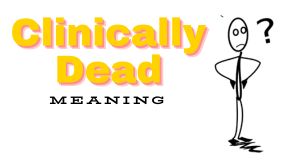
Clinically Dead
Here we give you more info about Clinically Dead: Meaning, Signs, Key Differences and all you need to know.
What Does It Mean to Be Clinically Dead?
The term clinically dead refers to a state where a person’s heartbeat and breathing have stopped, but the condition may still be reversible with medical intervention. Unlike biological death, which is permanent, clinical death is often a temporary state that can be reversed through immediate medical procedures like cardiopulmonary resuscitation (CPR) or defibrillation.
Clinically Dead vs. Brain Dead: Understanding the Difference
There is often confusion between clinical death and brain death. Here’s how they differ:
- Clinically Dead: The heart has stopped pumping blood, and breathing has ceased, but the brain may still have some residual activity. If treated promptly, the person can be revived.
- Brain Dead: This is an irreversible condition where all brain activity stops. A person who is brain dead cannot be revived, even if their heart is artificially kept beating with life support.
Signs of Clinical Death
When a person is clinically dead, they exhibit the following signs:
- No heartbeat
- No pulse
- No breathing
- Unconsciousness and unresponsiveness
- Dilated pupils that do not react to light
Is Clinical Death Actual Death?
Not necessarily. Clinical death is a critical phase but does not always mean the end of life. If medical intervention occurs within a few minutes, there is a chance of survival without severe complications. However, if oxygen supply to the brain is cut off for more than a few minutes, brain damage may occur, leading to either brain death or permanent disability.
How Long Can a Person Be Clinically Dead?
The duration a person can remain clinically dead before revival becomes impossible varies. Several factors influence this:
- Immediate medical response: The sooner CPR or defibrillation is performed, the higher the chances of survival.
- Temperature: In cases of hypothermia, where the body temperature is very low, the brain requires less oxygen, extending the time a person can be revived.
- Underlying health conditions: A younger, healthier individual may have better chances of revival compared to someone with pre-existing medical conditions.
In most cases, the brain begins to suffer irreversible damage within four to six minutes of oxygen deprivation, making swift medical action crucial.
Examples of Clinical Death and Survival
Many people have been revived after being declared clinically dead for a short time. Here are some notable cases:
- Drowning victims: Some individuals have survived after being submerged underwater for prolonged periods, especially in cold temperatures.
- Cardiac arrest survivors: People who have suffered sudden cardiac arrests and received immediate CPR have successfully recovered.
- Near-death experiences (NDEs): Some revived individuals report experiences of light, tunnels, or out-of-body sensations during their clinical death phase.
Legally Dead But Still Alive?
In some cases, individuals declared legally dead have been revived. Legal death is often determined by either the cessation of heart activity or brain activity. However, cases exist where individuals were revived even after being pronounced dead, leading to ethical and medical debates about when death should be officially declared.
Reversibility of Clinical Death
Modern medicine has advanced significantly in reversing clinical death. Some techniques include:
- CPR and defibrillation: Restoring heart rhythm through chest compressions or electric shocks.
- Advanced cardiac life support (ACLS): Using medications and specialized equipment to revive patients.
- Therapeutic hypothermia: Lowering body temperature to reduce brain damage and improve survival chances.
Conclusion
Being clinically dead does not always mean the end of life. It is a temporary and potentially reversible state, unlike brain death, which is permanent. Immediate medical intervention plays a crucial role in determining whether a person can be revived without significant brain damage.
Understanding the difference between clinical death, brain death, and legal death is essential, especially as medical advancements continue to challenge traditional definitions of life and death.






